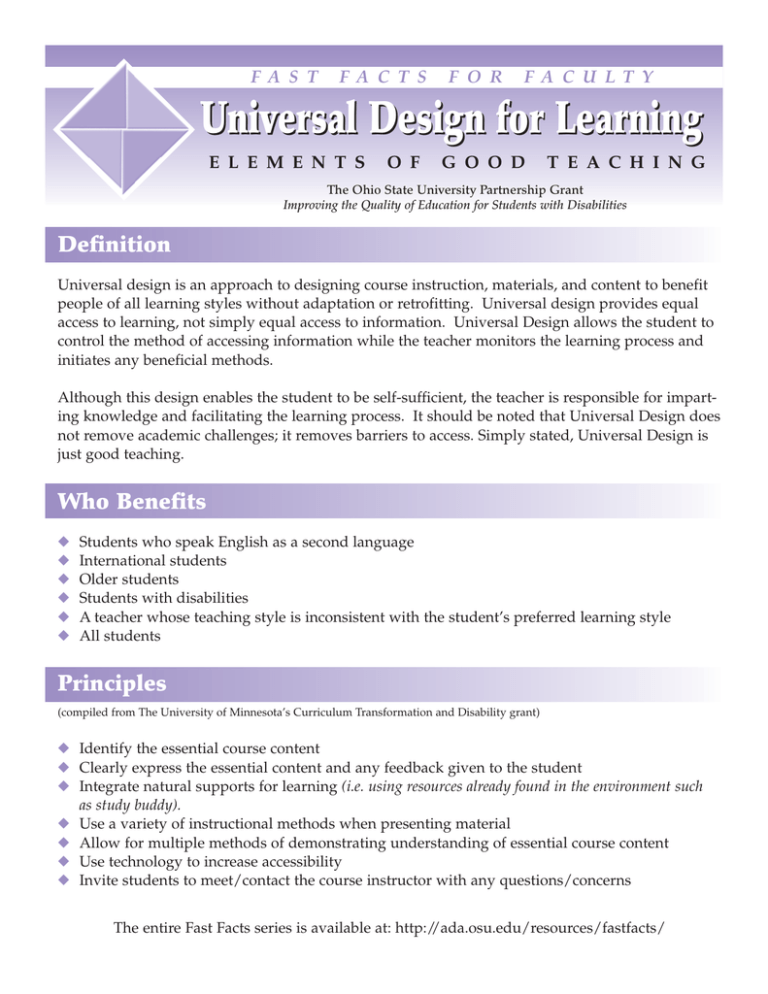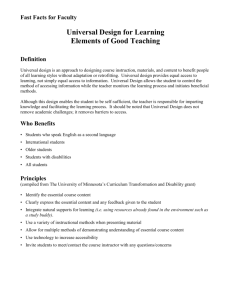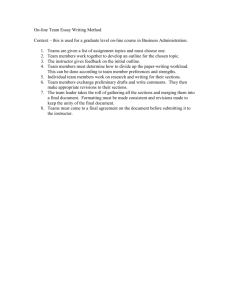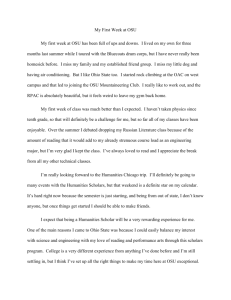Universal Design for Learning Definition
advertisement

F A S T F A C T S F O R F A C U L T Y Universal Design for Learning E L E M E N T S O F G O O D T E A C H I N G The Ohio State University Partnership Grant Improving the Quality of Education for Students with Disabilities Definition Universal design is an approach to designing course instruction, materials, and content to benefit people of all learning styles without adaptation or retrofitting. Universal design provides equal access to learning, not simply equal access to information. Universal Design allows the student to control the method of accessing information while the teacher monitors the learning process and initiates any beneficial methods. Although this design enables the student to be self-sufficient, the teacher is responsible for imparting knowledge and facilitating the learning process. It should be noted that Universal Design does not remove academic challenges; it removes barriers to access. Simply stated, Universal Design is just good teaching. Who Benefits ◆ ◆ ◆ ◆ ◆ ◆ Students who speak English as a second language International students Older students Students with disabilities A teacher whose teaching style is inconsistent with the student’s preferred learning style All students Principles (compiled from The University of Minnesota’s Curriculum Transformation and Disability grant) ◆ Identify the essential course content ◆ Clearly express the essential content and any feedback given to the student ◆ Integrate natural supports for learning (i.e. using resources already found in the environment such as study buddy). ◆ Use a variety of instructional methods when presenting material ◆ Allow for multiple methods of demonstrating understanding of essential course content ◆ Use technology to increase accessibility ◆ Invite students to meet/contact the course instructor with any questions/concerns The entire Fast Facts series is available at: http://ada.osu.edu/resources/fastfacts/ The Ohio State University Partnership Grant Improving the Quality of Education for Students with Disabilities Common Teaching Methods Strengths Lecture ◆ Ensures dissemination of specific facts ◆ Class size is not an issue Limitations ◆ Little, if any, student participation ◆ Only learn from one source Class Discussion ◆ Information and ideas ◆ Only practical with drawn from multiple people ◆ Student’s attention easily maintained small classroom ◆ Some students will monopolize the conversation while others will not engage in discussion Preparation ◆ Information to be learned needs to be clearly indicated ◆ Course instructor should allot adequate time for content to be presented ◆ Course instructor needs to guide discussion and keep group from going "off-track" ◆ Discussion topics/questions should be prepared before class Role Playing ◆ Can be very impacting ◆ Students may feel ◆ Students are able to "put on the spot" test concepts and ◆ Only practical for techniques presented small classroom in class ◆ Course instructor needs to identify rules, situation and roles Guest Speaker ◆ Provides a real-life example ◆ Gives students contacts in the field ◆ Quality of the speaker may be poor ◆ Identify and schedule appropriate speakers ◆ Provide introduction and background of speaker ◆ Speakers may be poor quality ◆ Competition among experts ◆ Identify and schedule experts ◆ Provide introduction and background of experts Panel of Experts ◆ Allows for multiple expert opinions and ideas on a topic ◆ May capture more students’ attention Videotapes* ◆ Allows for alternate ◆ Students do not have means of representation to actively participate ◆ Keeps students’ ◆ Unable to control attention what students learn from video * The Ohio State University Partnership grant strongly recommends that all videotapes be captioned. 2 ◆ Required to operate equipment ◆ Prepare questions for discussion after video The Ohio State University Partnership Grant Improving the Quality of Education for Students with Disabilities Implementation ◆ Put course content on-line allowing students to "pick up" material that might have been missed in lecture ◆ Use peer mentoring, group discussions, and cooperative learning situations rather than strictly lecture ◆ Using guided notes enables students to listen for essential concepts without copying notes off of overhead ◆ Update course materials based on current events and student demands ◆ Provide comprehensive syllabus with clearly identified course requirements, accommodation statement, and due dates ◆ Fluctuate instructional methods, provide illustrations, handouts, auditory and visual aids ◆ Clarify any feedback or instructions, ask for questions, and use multiple examples ◆ Relate a new topic to one already learned or a real-life example ◆ Secure a note taker, allow the student to tape record lectures or provide him/her with a copy of your notes ◆ Allow the student to demonstrate knowledge of the subject through alternate means ◆ Permit and encourage the use of adaptive technology ◆ Develop study guides ◆ Give shorter exams more frequently For a definition of bolded terms, please visit our web site at www.telr.osu.edu/dpg/glossary.html 3 The Ohio State University Partnership Grant Improving the Quality of Education for Students with Disabilities Essential Qualities Course content offers various methods of Course content offers various methods of Course content offers various methods of Representation Engagement Expression Universally designed course content provides alternative representations of essential concepts. Faculty should use various methods of representation to allow the student to learn the information in their preferred means. Universally designed course content maintains varied skill levels, preferences, and interests by allowing for options. By having flexible teaching strategies and course content, students can choose methods that support their interest and skill levels. Universally designed course content allows for alternate methods of expression. This allows the student multiple means of demonstrating mastery of the material. Example: Placing course notes on the web allows students to gain the information by lecture and text. Additionally, a student with a visual impairment could tape record the lecture to capture the notes in alternate format. Example: When teaching a foreign language, students could choose from a variety of on-line options that would allow them to practice fluency and comprehension at a reading level that is appropriate for them. Example: Allowing the students to demonstrate knowledge on a subject by doing an oral presentation or writing a paper or taking a test. Students with a speech impediment may be unable to present the information orally while students with a fine motor disability may have difficulty taking a written exam. Resources Universal Design. [on-line]. Available: http://www.cast.org University of Minnesota’s Curriculum Transformation and Disability. Funded by the US Department of Education. Project #P333A990015. Ways to Incorporate Universal Instructional Design. Honolulu Community College’s Common Teaching Methods [on-line]. Available: http://www.hcc.hawaii.edu/intranet/committees/FacDevCom/guidebk/teachtip/comteach.htm Do-It. University of Washington. Funded by the National Science Foundation, The US Department of Education, and the State of Washington. Grant # 9725110 [on-line]. Available: http://www.washinton.edu/doit/. University of Arkansas at Little Rock. College of Education. [on-line]. Available: www.ualr.edu/~coedept/curlinks/sped.html This publication is funded by the U.S. Department of Education under grant #P333A020033-03. For additional copies or more information, please contact: Margo Izzo, Ph. D., Phone: 614-292-9218, Email: izzo.1@osu.edu or visit our web site at http://ada.osu.edu/resources/fastfacts/ 4






